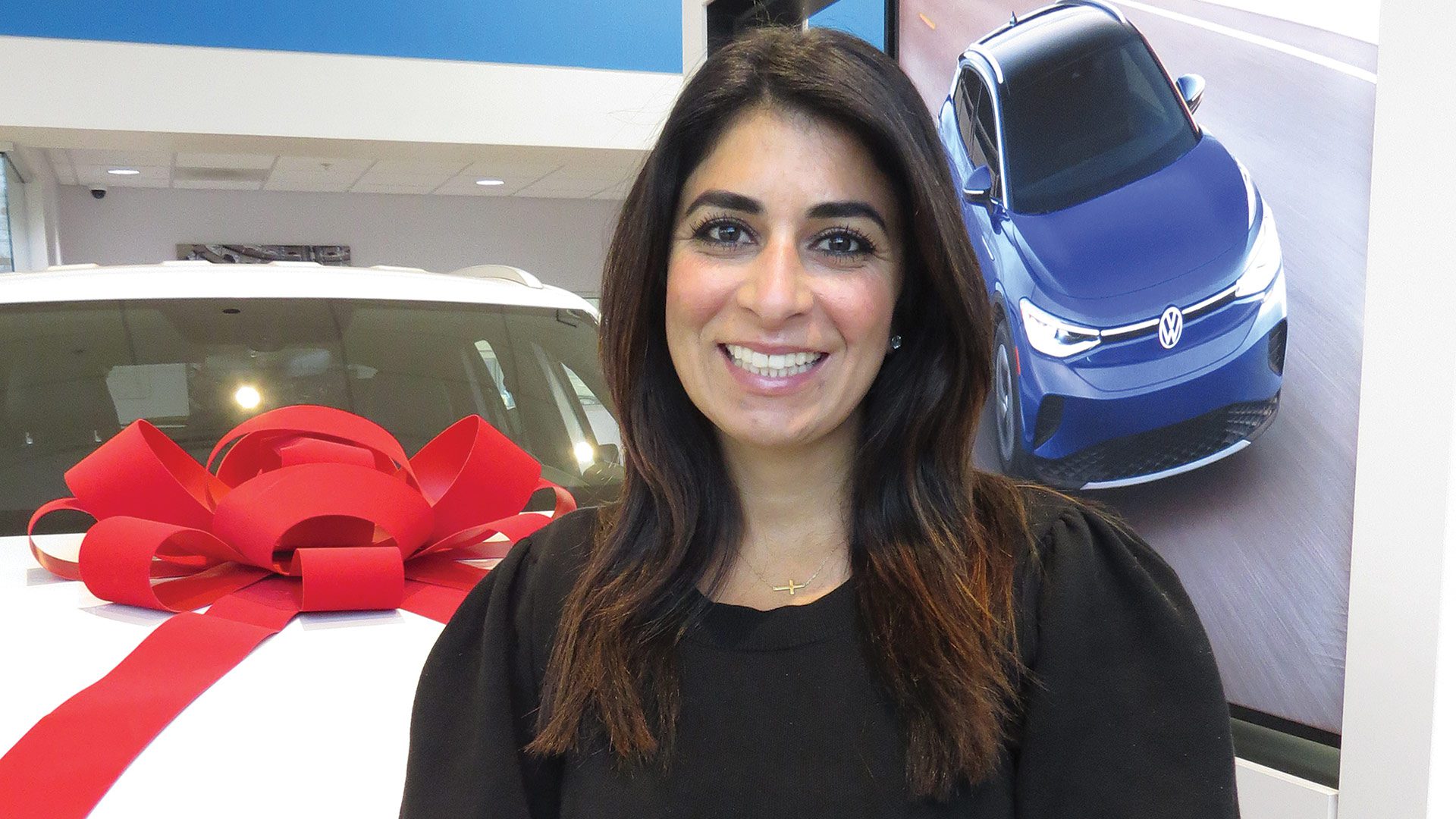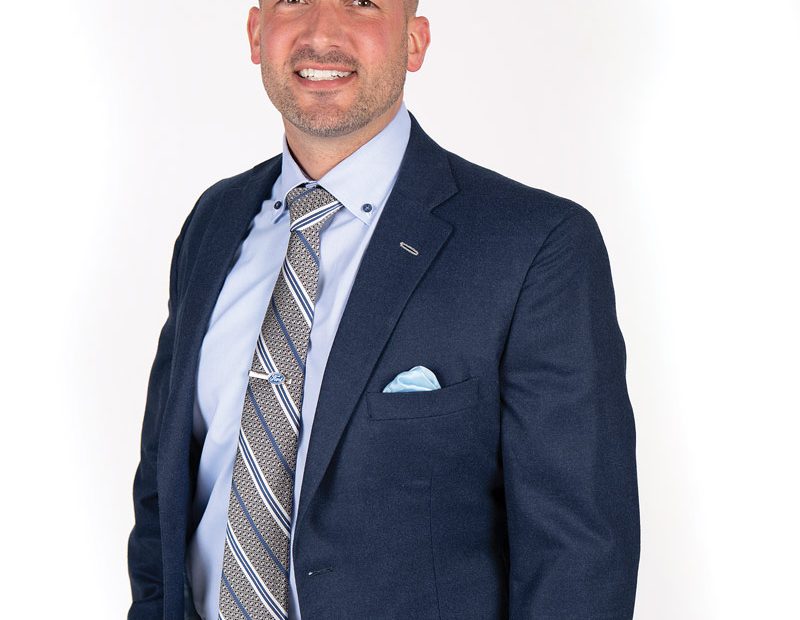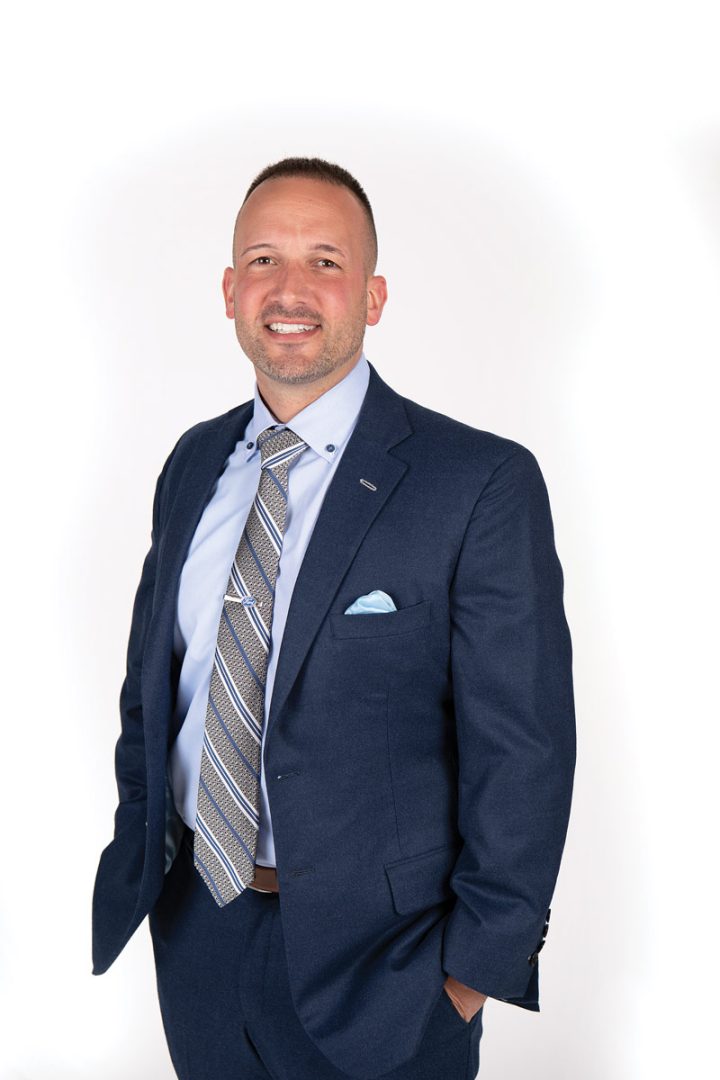Driving Forces

Mike Marcotte shows off one of the Bronco Sport models on the Marcotte lot, one of the small SUVs that are seeing a surge in popularity.
Prior to the pandemic, Mike Marcotte recalls, there would be between 300 and 350 new cars on the lot at Marcotte Ford, the Holyoke mainstay started by his grandfather more than a half-century ago.
At the height of COVID, when there were supply-chain issues and a massive microchip shortage, there were maybe 30 or 40 cars on that same lot.
“Employees could park wherever they wanted at that time,” Marcotte, the company’s president, said with a laugh, noting that today, there are close to 200 cars on the lot on Main Street, partly out of necessity — there are still fewer cars available from the manufacturer — but also out of choice.
“You don’t need to have everything on the lot because you can factory-order vehicles,” he explained. “It’s nice to have all the options, but you have carrying costs, and you want the freshest product.”
This commitment to keeping smaller inventory levels has provided the business with another opportunity to expand what has become a complex of sorts on Main Street, one that includes everything from the dealership to a commercial truck center to a car wash. Indeed, Marcotte showed BusinessWest a row in the parking lot that is now the site of a construction project — one that will create a bank of charging stations to handle the growing volume of electric-car sales.
“You don’t need to have everything on the lot because you can factory-order vehicles.”
Rising electric and hybrid car sales and smaller inventories, by choice, are among the trends and ongoing developments in an auto-sales industry that is still in many ways adjusting to life post-COVID. It’s a time of challenge — higher interest rates, talk of recession, and some lingering availability issues when it comes to many makes and models, for example — but also opportunity, in the form of new and intriguing products (mostly those electric models), some improved incentives from the manufacturers, and some lingering, pent-up demand.
Other trends include a still-challenging used-car market — meaning challenging for dealers who struggle to find cars and challenging for consumers, who continue to face limited options and high prices — as well as steadily rising SUV sales and a growing willingness among consumers to order a vehicle rather than pick one off the lot.
Carla Cosenzi, president of the Tommy Car Auto Group, which includes Hyundai, Genesis, Nissan, Volkswagen, and Volvo dealerships, said she and her team, like most in this business, entered the year with conservative expectations, because of those challenges listed above, and two quarters into 2023, they are meeting them.
“It’s been such a volatile market, with inventory constraints, interest rates, and what’s happening with the economy, so we just made a conservative projection and figured we could always adjust if we needed to,” Cosenzi said. “We projected to increase sales over last year, which we always do, but not by a lot.”
Ben Sullivan, chief operating officer at Balise Motor Sales, concurred. He told BusinessWest that, after three years of decline, to one degree or another, and a 2022 that was essentially flat, 2023 was seen within the industry as a year when, despite higher interest rates and inflation, dealers would do some catching up.

Ben Sullivan, seen here with a Kia Sportage plug-in hybrid, said electric cars and plug-ins comprise a growing percentage of sales at the company’s many dealerships.
And they have, he said, although limited supplies have impacted the degree that they can do so, with some brands impacted more than others. He noted that, while there are still some supply-chain issues, the bigger challenge now is getting the cars to the lots.
“There’s still some fragility in the supply chain,” Sullivan said. “On top of chips and COVID lockdowns, which, for most part, have passed in the global supply chain, now what you’re dealing with are labor shortages at ports and shortages of rail cars — there’s a particular type of rail car that carries vehicles. And on top of that, at the end of this year, the domestic manufacturers will be renegotiating their AUW contracts.”
For this issue and its focus on auto sales, BusinessWest talked with several dealers about what’s happening with this market at the halfway point in the year, and what we can expect in quarters three and four — and beyond.
To a Higher Gear
Before addressing 2023, Sullivan first set the tone by recapping 2022, which was, by most measures, and especially the new-car-sales yardstick, a down, or flat, year. And the availability of cars, or the lack thereof, was the biggest factor.
“Every time we thought that someone was going to build enough cars to grow sales, they weren’t able to, or they weren’t able to ship them,” he explained, listing issues ranging from plant lockdowns due to COVID to a computer-chip shortage and backups at the ports. “So the industry was really under some pressure.”
“People like to feel and touch and experience what they’re going to be driving, so there’s definitely an opportunity to lose market when you don’t have the right inventory and your competitor does.”
The consensus within this sector was that things would rebound somewhat in 2023, but the bounce would be limited by everything from lingering shipping challenges to higher interest rates to inflation limiting consumers’ buying power.
And all that has come to pass, said those we spoke with, noting that one of the biggest issues still facing dealers is inventory. Indeed, while most all of them would carry fewer vehicles than they did before the pandemic, for those reasons mentioned above, they would prefer more than they have at present — at least with most models.
Cosenzi, like Sullivan, said inventory levels vary with the brand, with some manufacturers faring better at bringing cars to the lot than others.
“Hyundai has inventory, and inventory is becoming more available every month,” she said. “Meanwhile, Volkswagen’s inventory isn’t nearly as robust as Hyundai’s, and with Nissan, we’re slowly seeing it grow, but it’s not faring as well as Hyundai.
“Obviously, we’ve learned to be more disciplined through COVID and not having as much inventory, and I think that has trained the consumer to some respect,” she went on. “However, people like to feel and touch and experience what they’re going to be driving, so there’s definitely an opportunity to lose market when you don’t have the right inventory and your competitor does.”

Carla Cozensi says inventory issues are among the many challenges facing dealers today.
Sullivan said inventories are generally improving across the spectrum of brands in the Balise stable, which now includes a second Subaru store (the other is in Rhode Island), with the quiet acquisition of the Steve Lewis dealership on Route 9 in Hadley early this spring. Overall, 60% of cars are now pre-sold, or factory-ordered, compared with 80% to 90% at the height of COVID.
Overall, he said, there is now more of a willingness on the part of consumers to factory-order vehicles and get exactly what they want — and wait several weeks for it — while rising inventory levels improve the odds of getting exactly what they want (or at least close) and driving it off the lot the same day.
Marcotte said levels of inventory are rising at his Ford store, but a good number of vehicles — maybe 33% of all sales, by his estimate — are still factory-ordered, with wait times of roughly six to 12 weeks, compared with four to six months at the height of COVID.
“It’s back to normal in many respects, but you’re still dealing with some supply issues; it may not be microchips, but other parts — one widget can hold up a whole vehicle,” he said, adding that it can still be challenging to secure adequate inventories of some product, especially, in his case, trucks and cargo vans.
Current Events
But while challenges persist, those we spoke with have seen several encouraging trends and developments.
At the top of that list is electric vehicles and hybrids, sales of which have been climbing steadily, if unspectacularly, over the past several years.
Within the Balise stable, Sullivan said, there are now 15 electric models, with more on the way, when a few years ago, there were just three.
“It’s back to normal in many respects, but you’re still dealing with some supply issues; it may not be microchips, but other parts — one widget can hold up a whole vehicle.”
“Soon, there are going to be 54 entries into just the electric-vehicle market,” he said. “And it’s going to be a very interesting landscape to watch as people decide, ‘can I go all the way in electric, and which one do I get, based on range and price and tax credits?’
“It is certainly a growing part of the business, but what’s interesting to watch as well is the number of people who go out with an electric and decide they’ll take one step away from that and go plug-in hybrid,” he went on. “We’re seeing a real demand push going on for plug-in hydrids; the hybrids have been around for a while, but the plug-in hybrid is really starting to come into its own. We’re seeing a huge increase in demand for those vehicles.”
Meanwhile, sales of SUVs, especially the smaller, crossover models, continue to dominate the market.
Some makers have all but stopped selling sedans — Ford has only the Mustang left in its portfolio, for example — amid growing popularity of SUVs, which appeal to consumers of all ages.
Cosenzi said sales of models such as the Hyundai Tuscon, Nissan Rogue, Volkswagen Tiguan, and Volvo XT60 continue to trend higher. There is still a market for sedans, she went on, noting that VW’s Jetta and Hyundai’s Elantra, both smaller models with comparatively smaller price tags, are still a strong seller. But that market is smaller and continuing to trend in that direction.
Marcotte concurred, pointing to soaring demand for the Ford Bronco and Bronco Sport, a smaller SUV that is capturing an audience.
“We’re getting a lot of new buyers because of the style of the Bronco Sport — we’ve had some Escape customers, people who have bought two or three Escapes, moving to the Bronco Sport,” he said, adding that another popular addition to the portfolio is the Maverick, a small truck that gets 40 miles to the gallon and lists for under $30,000.
As for the used-car market, 2023 has looked a whole lot like … well, 2022, said those we spoke with, much to the chagrin of consumers and dealers alike.
The problem, now and then, is inventory, or lack thereof, said Cosenzi, adding that supplies remain low, for many reasons. These include fewer new-car sales (compared to pre-pandemic levels) and, therefore, fewer trade-ins, as well as the fact that seemingly all constituencies, from consumers to car-rental companies, are hanging onto their cars longer.
That means there are fewer pre-owned cars on the lots, which equates to higher prices, a simple byproduct of the laws of supply and demand that is not likely to change any time soon, Sullivan said.
Cosenzi agreed, noting that dealers can’t get as many cars, and they have to work much harder to secure what they can.
“We’ve done a really good job sourcing them from our own customers, like marketing to people in our market that we’re interested in buying their car, and that’s how we’ve been able to maintain our levels,” she said. “But it’s been difficult. It’s been more work than it’s been in the past, that’s for sure.”
The Road Ahead
Summing up the mindset at Balise, Sullivan said the company is “bullish,” and in a growth mode.
And, increasingly, it is securing the fuel it needs for such growth — fuel in the form of inventory, demand for products (especially the new electric vehicles and SUVs now dominating the lots), and economic conditions that will prompt consumers to buy.
Time will tell what happens over the final two quarters of this year, but it seems likely that dealers will do more of that catching up that was projected for 2023.





 He calls it the ‘Marcotte Ford campus,’ and that name certainly works.
He calls it the ‘Marcotte Ford campus,’ and that name certainly works.


